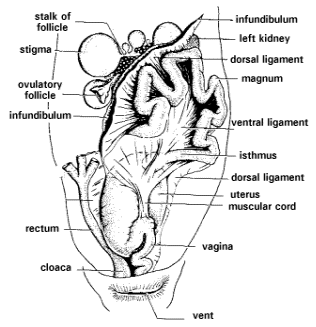The avian egg goes through three major stages in its life, the process of forming the egg, incubation after the egg is laid and finally the hatching of the chick. Each stage is a wonder of nature and has its own unique processes.
The Forming of the Egg
It takes approximately 25 hours for an egg to travel along the female reproductive tract. Most species of birds have only a functional left ovary and oviduct, the right ovary and oviduct having undergone regression (shrinking).
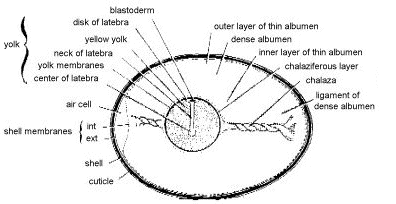 The yolk components of the egg – proteins and lipids – are manufactured in the liver and transported by the blood to the ovary. Formation of the yolk membrane’s outer layers – the chalaziforous layer of the albumen as well as the chalazae – begin in the tubular portion of the infundibulum. The yolk membranes form a barrier between the yolk and albumen that is very strong yet permeable to water and salts. The yolk is suspended in the center of the egg by twisted strands of protein fibers called chalazae.
The yolk components of the egg – proteins and lipids – are manufactured in the liver and transported by the blood to the ovary. Formation of the yolk membrane’s outer layers – the chalaziforous layer of the albumen as well as the chalazae – begin in the tubular portion of the infundibulum. The yolk membranes form a barrier between the yolk and albumen that is very strong yet permeable to water and salts. The yolk is suspended in the center of the egg by twisted strands of protein fibers called chalazae.
Ferilization occurs in the funnel portion of the oviduct. The first cell division occurs approximately 5 hours after ovulation and continues as the yolk travels down the oviduct.
Reproductive Tract

The egg membranes (the amnion, chorion, and allantois) develop from the embryo. An outgrowth of the embryo’s digestive system surrounds the yolk, forming the yolk sac. The amnion and chorion develop as folds of the body wall and surround the embryo. The amnion becomes a fluid filled sac in which the embryo grows. The allantois, an extension of the embryo’s digestive tract, fuses with the chorion forming the chorioallantoic membrane. This membrane contains many blood vessels allowing oxygen and carbon dioxide to be exchanged through the shell.The magnum is the longest and most coiled portion of the hen’s oviduct. Many secretory glands are present which secrete albumen around the ovum. Albumen contributes to the aqueous environment around the embryo, has antibacterial properties and is a source of nutrition for the embryo. The developing egg remains in the magnum for 3 hours.
Inner and outer shell membranes are secreted by the portion of the oviduct known as the isthmus. The egg remains in the isthmus for 1 1/2 hours.
The developing egg spends most of its time in the uterus – approximately 20 hours. During the first 8 hours ‘plumping’ occurs – which is the addition of watery solutions from glands in the uterus. The egg doubles in weight during this time.
Once plumping occurs, the egg shell is secreted. It is composed of an inner and outer shell membrane, a testa and a cuticle. The testa forms the greatest portion of the shell and is primarily composed of calcium carbonate. High levels of circulating calcium are necessary for shell formation. Increased intestinal absorption and mobilization of calcium from the hen’s bones play important roles in providing the calcium for shell formation. Hens fed a diet low in calcium will produce thin-shelled eggs and baby birds with poor bone quality. The hen’s own skeleton will become calcium depleted increasing susceptablility to the development of multiple bone fractures and possibly becoming egg bound.
Shell thickness varies among species with larger birds having thicker shells than smaller birds. Openings known as ‘pores’ open on the surface of the egg and extend down to the shell membrane. These pores allow oxygen, carbon dioxide and water to pass through the shell.
A water repellent layer, the cuticle, lies over the testa and pores. The cuticle decreases water loss and acts as a barrier to bacteria. Although the pores are covered by the cuticle, tiny cracks in the cuticle allow the pores to remain permeable to gases.
The egg passes through the vagina in a matter of seconds as it passes out of the hen.
Once outside the hen’s body the egg begins to cool. The cooling enables the air cell to form by the separating of the outer and inner membranes at the blunt end of the shell. The head of the embryo lies close to the air cell. This end is the point of exit for the hatching chick.
The Developing Egg
Parents may not begin to incubate their eggs until their entire clutch is laid. The environmental temperature is critical to survival of the embryo. If eggs are exposed to temperatures below the hen’s normal body temperature the embryo may die.
As the egg cools after laying, the air cell forms and environmental contaminants such as bacteria can be drawn through the pores into the egg. The length of time required for incubation varies among different species, in parrots 20 – 30 days is usual. During the incubation period, the parents turn their eggs to insure that the chick develops normally. In eggs that are not turned, the embryo will not survive. It will adhere to the top portion of the egg shell and will stop developing.
The embryo can be observed in the egg by ‘candling’ (shining a bright light through the egg) to determine if it is fertile and whether it is developing normally. This may be done several days after the egg is laid and at 3 day intervals during incubation. However, care should be taken as some parents will abandon their eggs if disturbed.
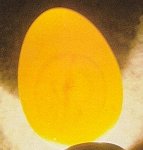 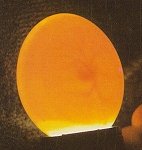 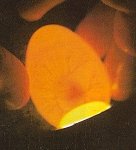 |
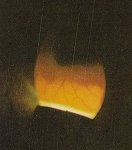 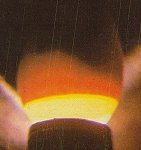 4 days 6 days 9 days 19 days 24 days |
The Hatching Egg

As the embryo develops, the egg loses water by transpiration through the chorioallentoic membrane. This loss of water, as well as the loss of yolk fats used by the embryo, cause the egg to be lighter at hatching. The egg shell is thinner at hatch because the chick has absorbed most of the calcium from the inner shell lining.
Baby birds have two unique structures that aid their hatching. A temporary ‘egg tooth’ develops on the dorsal tip of the upper beak that enables the chick to ‘pip’ and cut its way out of the shell. This structure is lost several weeks post-hatch.
An enlargement in a muscle in the back of the neck – the complexus or pipping muscle – helps the chick force the egg tooth through the shell. After hatching, most of the fluid in this muscle is absorbed and the muscle continues to function as an extender of the neck.
Just before hatching begins, the air cell expands to approximately 30% of the internal volume of the egg. As hatching begins, the beak of the embryo penetrates the inner shell membrane where it forms the inner wall of the air cell. The lungs begin to function, inhaling the air from the air cell. This is known as ‘internal pipping’. The trigger for internal pipping is an increase in carbon dioxide in the blood. The ‘external pip’ occurs when the chick cuts the outer shell membrane and shell. The egg tooth is used to help the baby cut its way out of the shell. Increasing carbon dioxide in the air chamber triggers contractions of the hatching muscle which assists the baby’s efforts. It usually takes 24 hours from internal pip to completed hatch in most parrot species.
Precocial species, such as shorebirds, gamebirds, chickens and waterfowl, have large eggs. Their chicks hatch with open eyes and thick coats of down and are capable of leaving their nest within several days after hatching.
Altricial chicks, such as songbirds and parrots, have smaller eggs. The chicks are blind and naked, requiring long periods of parental care and feeding before they can be on their own.


